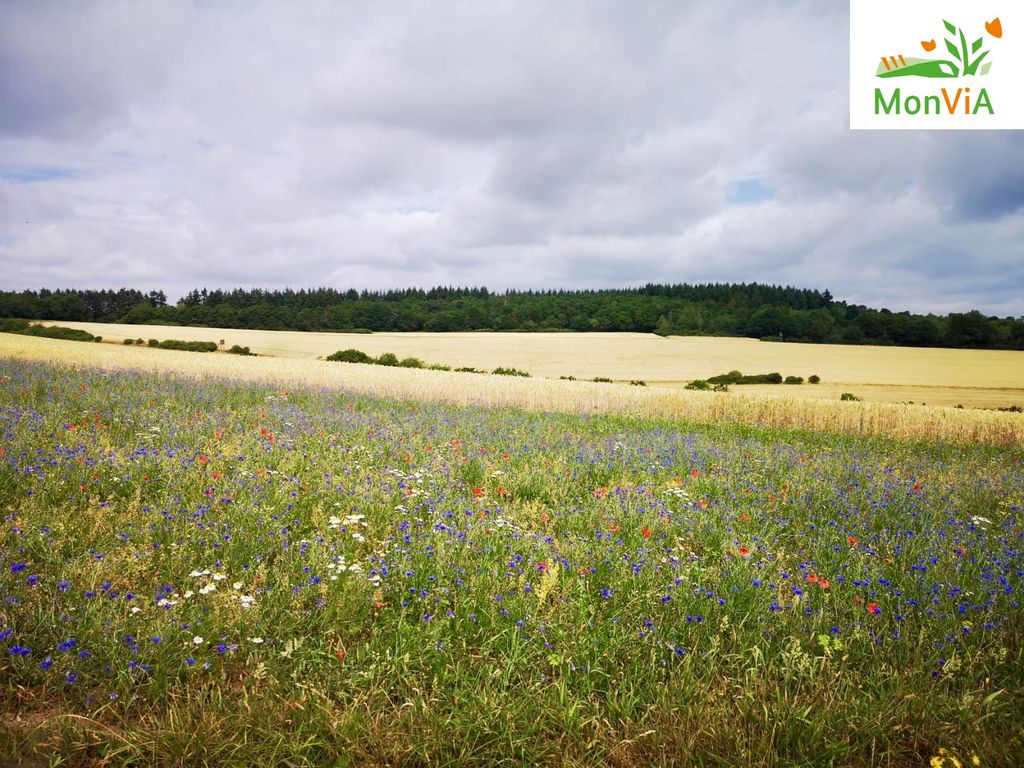Project
MonViA: German farmland biodiversity monitoring

German farmland biodiversity monitoring
Far reaching changes in production systems and in farm management have led to a decline in farmland biodiversity. To counteract this decline, a national database is needed that allows conclusions to be drawn about cause-effect relationships.
Background and Objective
In Germany, around 50 percent of the land is used for agricultural purposes. Therefore, agriculture plays an important role in the conservation and promotion of farmland biodiversity. In particular, land-use and farm management, and closely linked to this, the configuration of agricultural landscapes, are mainly responsible for the decline in farmland biodiversity. Since existing monitoring programmes only allow to a limited extent scientifically reliable conclusions on underlying cause-effect relationships and on evaluations of the effectiveness of agri-environmental policy measures to promote farmland biodiversity, a representative nationwide data basis is required.
In the joint project MonViA, scientists want to provide well-founded answers to the following questions:
- How does agricultural production, changes in land- use and agricultural structure influence farmland biodiversity?
- How do changes in farmland biodiversity affect the performance and stability of agricultural production systems?
- How do agri-environmental policy instruments affect farmland biodiversity?
Target Group
Agriculture, science, politics
Approach
MonViA is designed to complement existing nature conservation monitoring schemes and starts with a 5-year pilot phase in which standardised sampling methods are developed and feasibility studies for the development of innovative indicator systems are carried out. MonViA consists of three monitoring sections: a nationwide general trend monitoring, a question-based monitoring on specific agricultural issues and a Citizen Science-based monitoring. In the latter case, farmers in particular are to be involved in monitoring activities.
MonViA deals, in addition to the diversity and quality of habitats, with different groups of organisms. The focus is on functional groups (pollinators, pests, beneficial organisms, soil fauna) that are of particular importance for the performance of agricultural production systems.
The scientific conception and development of MonViA is carried out by a total of 12 specialist institutes of the Thünen Institute and the Julius Kühn Institute. The Information and Coordination Centre of Biological Diversity of the Federal Agency for Agriculture and Food is responsible for the presentation of results for politicians and the public. The overall coordination of the joint project is carried out by the Thünen Institute of Biodiversity.
Links and Downloads
More information on MoViA and all projects are available on the website of the joint-project:
www.agrarmonitoring-monvia.de
Thünen-Contact

Involved Thünen-Partners
- Ackermann, AndreaLV Institute of Rural Studies
- Dauber, JensBD Institute of Biodiversity
- Erasmi, StefanBW Institute of Farm Economics
- Erasmi, StefanBW Institute of Farm Economics
- Grabener, SwantjeBD Institute of Biodiversity
- Kasiske, ToniBD Institute of Biodiversity
- Kirsch, FelixBD Institute of Biodiversity
- Klimek, SebastianBD Institute of Biodiversity
- Kroll, DanaBD Institute of Biodiversity
- Krüger, LasseBD Institute of Biodiversity
- Laggner, BirgitLV Institute of Rural Studies
- Levers, ChristianBD Institute of Biodiversity
- Niemann, ChristophLV Institute of Rural Studies
- Ogan, SophieKB Coordination Unit Climate, Soil, Biodiversity
- Ogan, SophieKB Coordination Unit Climate, Soil, Biodiversity
- Ogan, SophieKB Coordination Unit Climate, Soil, Biodiversity
- Pao, Yi-ChenLV Institute of Rural Studies
- Rakosy, DemetraBD Institute of Biodiversity
- Röder, NorbertLV Institute of Rural Studies
- Schrader, StefanBD Institute of Biodiversity
- Schwieder, MarcelBW Institute of Farm Economics
- Seah, BrandonBD Institute of Biodiversity
- Seide, YvonneBD Institute of Biodiversity
- Sickel, WiebkeBD Institute of Biodiversity
- Sommerlandt, FrankBD Institute of Biodiversity
- Stahl, JohannaBD Institute of Biodiversity
- Tebbe, ChristophBD Institute of Biodiversity
- Thiele, JanBD Institute of Biodiversity
Funding Body
-
Federal Ministry of Agriculture, Food and Regional Identity (BMLEH)
(national, öffentlich)
Duration
Permanent task 1.2019
More Information
Project status:
ongoing
Publications to the project
- 0
Lobert F, Schwieder M, Hostert P, Gocht A, Erasmi S (2025) Characterizing spatio-temporal patterns of winter cropland cover in Germany based on Landsat and Sentinel-2 time series. Int J Appl Earth Observ Geoinf 142:104728, DOI:10.1016/j.jag.2025.104728
- 1
Gornall L, Dauber J, Sickel W (2025) Population delimitation in bumble bees - strategies and research gaps. Front Bee Sci 3:1507903, DOI:10.3389/frbee.2025.1507903
- 2
Lobert F, Schwieder M, Alsleben J, Brög T, Kowalski K, Okujeni A, Hostert P, Erasmi S (2025) Unveiling year-round cropland cover by soil-specific spectral unmixing of Landsat and Sentinel-2 time series. Remote Sens Environ 318:114594, DOI:10.1016/j.rse.2024.114594
- 3
Mupepele A-C, Hellwig N, Dieker P, Klein A-M (2025) What evidence exists on wild bee trends in Germany? A systematic map. Environ Evid 14:11, DOI:10.1186/s13750-025-00364-7
- 4
Sommerlandt FMJ, Ogan S, Lakemann L, Rákosy D (2024) Bestäuber im Fokus: Das Hummel-Monitoring in Agrarlandschaften. Biol Unserer Zeit 54(4):327-329, DOI:10.11576/biuz-7588
- 5
Ogan S, Guggemoos T, Kirsch F, Lakemann L, Sommerlandt FMJ, Witt R (2024) Erstnachweis von Bombus argillaceus (Scopoli, 1763) (Hymenoptera, Anthophila) für Deutschland [online]. Ampulex 15:46-49, zu finden in <www.ampulex.de/images/ampu15.pdf> [zitiert am 12.11.2024]
- 6
Weber D, Schwieder M, Ritter L, Koch T, Psomas A, Huber N, Ginzler C, Boch S (2024) Grassland-use intensity maps for Switzerland based on satellite time series: Challenges and opportunities for ecological applications. Remote Sensing Ecol Conserv 10(3):312-327, DOI:10.1002/rse2.372
- 7
Klaus F, Ayasse M, Classen A, Dauber J, Diekötter T, Everaars J, Fornoff F, Greil H, Hendriksma HP, Jütte T, Klein A-M, Krahner A, Leonhardt SD, Lüken DJ, Paxton RJ, Schmid-Egger C, Steffan-Dewenter I, Thiele J, Tscharntke T, Erler S, Pistorius J (2024) Improving wild bee monitoring, sampling methods, and conservation. Basic Appl Ecol 75:2-11, DOI:10.1016/j.baae.2024.01.003
- 8
Weber D, Schwieder M, Huber N, Ginzler C, Boch S (2024) Kartierung der Grünlandnutzung aus dem All - methodisches Vorgehen und ökologische Anwendung für die Schweiz. N+L Inside(1):35-39
- 9
Yang J, Schrader S, Tebbe CC (2024) Legacy effects of earthworms on soil microbial abundance, diversity, and community dynamics. Soil Biol Biochem 190:109294, DOI:10.1016/j.soilbio.2023.109294
- 10
Klein K, Ogan S, Tönshoff C, Böhner HGS, Dauber J, Erasmi S, Gocht A, Hellwig N, Klimek S, Krüger L, Lakemann L, Levers C, Lindermann L, Richter A, Röder N, Schwieder M, Sickel W, Sommerlandt FMJ, Stahl J, Tebbe CC, et al (2024) MonViA Indikatorenbericht 2024 : Bundesweites Monitoring der biologischen Vielfalt in Agrarlandschaften. Bonn: BLE, 199 p
- 11
Hellwig N, Sommerlandt FMJ, Grabener S, Lindermann L, Sickel W, Krüger L, Dieker P (2024) Six steps towards a spatial design for large-scale pollinator surveillance monitoring. Insects 15(4):229, DOI:10.3390/insects15040229
- 12
Settele J, Aracil A, Arnberg H, Aström S, Bacon J, Balalaikins M, Baldi A, Bane M, Barda M, Barea-Azcón J-M, Beckert J, Berlengée F, Bevk D, Biesmeijer JC, Bonelli S, Bosch J, Botham M, Bourn N, Dauber J, Dieker P, et al (2024) SPRING - strengthening pollinator recovery through indicators and monitoring. Leipzig: Helmholtz-Centre for Environmental Research, 116 p
- 13
Pham V-D, Tetteh GO, Thiel F, Erasmi S, Schwieder M, Frantz D, van der Linden S (2024) Temporally transferable crop mapping with temporal encoding and deep learning augmentations. Int J Appl Earth Observ Geoinf 129:103867, DOI:10.1016/j.jag.2024.103867
- 14
Frank C, Hertzog LR, Klimek S, Schwieder M, Tetteh GO, Böhner HGS, Röder N, Levers C, Katzenberger J, Kreft H, Kamp J (2024) Woody semi-natural habitats modulate the effects of field size and functional crop diversity on farmland birds. J Appl Ecol 61(5):987-999, DOI:10.1111/1365-2664.14604
- 15
Sickel W, Zizka V, Scherges A, Bourlat SJ, Dieker P (2023) Abundance estimation with DNA metabarcoding - recent advancements for terrestrial arthropods. Metabarcoding & Metagenomics 7:e112290, DOI:10.3897/mbmg.7.112290
- 16
Sickel W, Kulow J, Krüger L, Dieker P (2023) BEE-quest of the nest: A novel method for eDNA-based, nonlethal detection of cavity-nesting hymenopterans and other arthropods. Environmental DNA 5(6):1163-1176, DOI:10.1002/edn3.490
- 17
Gönner J von, Herrmann TM, Bruckermann T, Eichinger M, Hecker S, Klan F, Lorke J, Richter A, Sturm U, Voigt-Heucke S, Brink W, Liedtke C, Premke-Kraus M, Altmann C, Bauhus W, Bengtsson L, Büermann A, Dietrich P, Dörler D, Eich-Brod R, et al (2023) Citizen science's transformative impact on science, citizen empowerment and socio-political processes. Socio-ecol pract res 5(1):11-33, DOI:10.1007/s42532-022-00136-4
- 18
Pérez-Sánchez AJ, Schröder B, Dauber J, Hellwig N (2023) Flower strip effectiveness for pollinating insects in agricultural landscapes depends on established contrast in habitat quality: A meta-analysis. Ecol Solut Evid 4(3):e12261, DOI:10.1002/2688-8319.12261
- 19
Kasiske T, Dauber J, Harpke A, Klimek S, Kühn E, Settele J, Musche M (2023) Livestock density affects species richness and community composition of butterflies: A nationwide study. Ecol Indic 146:109866, DOI:10.1016/j.ecolind.2023.109866
- 20
Ayasse M, Fornoff F, Grabener S, Hoiß B, Hopfenmüller S, Hornby G, König C, Mayr A, Rest M, Reininghaus H, Schlager M, Schmid-Egger C, Seitz H, Sommerlandt FMJ, Tschöpe M, Zobel M (2023) Sammeln von Wildbienen in der Natur - Artenschutzfachliche Argumente : Biodiversität. Düsseldorf: VDI, 19 p, VDI Richtl
- 21
Mupepele A-C, Hellwig N, Dieker P, Klein A-M (2023) What evidence exists on wild-bee trends in Germany? Research protocol for a systematic map. PROCEED, 6 p, DOI:10.57808/proceed.2023.2
- 22
Bowler DE, Bhandari N, Repke L, Beuthner C, Callaghan CT, Eichenberg D, Henle K, Klenke R, Richter A, Jansen F, Bruelheide H, Bonn A (2022) Decision-making of citizen scientists when recording species observations. Sci Rep 12:11069, DOI:10.1038/s41598-022-15218-2
- 23
Hellwig N, Schubert LF, Kirmer A, Tischew S, Dieker P (2022) Effects of wildflower strips, landscape structure and agricultural practices on wild bee assemblages - A matter of data resolution and spatial scale? Agric Ecosyst Environ 326:107764, DOI:10.1016/j.agee.2021.107764
- 24
Schmidt A, Kirmer A, Hellwig N, Kiehl K, Tischew S (2022) Evaluating CAP wildflower strips: High-quality seed mixtures significantly improve plant diversity and related pollen and nectar resources. J Appl Ecol 59(3):860-871, DOI:10.1111/1365-2664.14102
- 25
Schubert LF, Hellwig N, Kirmer A, Schmid-Egger C, Schmidt A, Dieker P, Tischew S (2022) Habitat quality and surrounding landscape structures influence wild bee occurrence in perennial wildflower strips. Basic Appl Ecol 60:76-86, DOI:10.1016/j.baae.2021.12.007
- 26
Richter A, Hendriksma HP, Greil H, Gummert A, Kraft M, Ulber L, Redwitz Cv, Chiavassa JA, Lüken DJ (2022) Handreichung : Citizen Science-basiertes Monitoring der Biodiversität in Agrarlandschaften. Braunschweig: Thünen-Institut für Biodiversität, II, 24 p
- 27
Schwieder M, Wesemeyer M, Frantz D, Pfoch K, Erasmi S, Pickert J, Nendel C, Hostert P (2022) Mapping grassland mowing events across Germany based on combined Sentinel-2 and Landsat 8 time series. Remote Sens Environ 269:112795, DOI:10.1016/j.rse.2021.112795
- 28
Blickensdörfer L, Schwieder M, Pflugmacher D, Nendel C, Erasmi S, Hostert P (2022) Mapping of crop types and crop sequences with combined time series of Sentinel-1, Sentinel-2 and Landsat 8 data for Germany. Remote Sens Environ 269:112831, DOI:10.1016/j.rse.2021.112831
- 29
Richter A (2022) Quality assurance indicators for environmental citizen science : development of indicators for volunteer-based biodiversity monitoring. Fteval journal 53:68-80, DOI:10.22163/fteval.2022.573
- 30
Wolters V, Feindt PH, Dauber J, Bahrs E, Finckh M, Graner A, Jaenicke H, Krämer F, Kreuter-Kirchhof C, Schleip I, Schröder S, Tholen E, Wagner S, Wätzold F, Wedekind H, Weigend S, Wolf H, Zander K (2022) Synergien nutzen: Für die Beteiligung des BMEL an der neuen Nationalen Biodiversitätsstrategie. Kurzstellungnahme des Wissenschaftlichen Beirats für Biodiversität und Genetische Ressourcen beim Bundesministerium für Ernährung und Landwirtschaft. 7 p
- 31
Sietz D, Klimek S, Dauber J (2022) Tailored pathways toward revived farmland biodiversity can inspire agroecological action and policy to transform agriculture. Comm Earth Environ 3:211, DOI:10.1038/s43247-022-00527-1
- 32
Hertzog LR, Röder N, Frank C, Böhner HGS, Kamp J (2022) Village modernization and farmland birds: A reply to Rosin et al. (2021). Conserv Lett 15(2):e12874, DOI:10.1111/conl.12874
- 33
Lobert F, Holtgrave A-K, Schwieder M, Pause M, Gocht A, Vogt J, Erasmi S (2021) Detection of mowing events from combined Sentinel-1, Sentinel-2, and Landsat 8 time series with machine learning. Grassl Sci Europe 26:123-125
- 34
Tetteh GO, Gocht A, Erasmi S, Schwieder M, Conrad C (2021) Evaluation of sentinel-1 and sentinel-2 feature sets for delineating agricultural fields in heterogeneous landscapes. IEEE Access 9:116702-116719, DOI:10.1109/ACCESS.2021.3105903
- 35
Yang J, Wang H, Samad MS, Tebbe CC (2021) Fine-scale temporal monitoring of soil microbial communities at an agricultural field site. Verhandl Gesellsch Ökol 50: 133
- 36
Böhner HGS, Joormann I (2021) Fördermaßnahmen aus Agrarumweltprogrammen. Ökol Wirtschaften 36(4):19-20, DOI:10.14512/OEW360419
- 37
Pérez Sánchez AJ, Dauber J (2021) How beneficial are flower strips for biodiversity in European agricultural landscapes? Verhandl Gesellsch Ökol 50: 316
- 38
Hertzog LR, Frank C, Klimek S, Röder N, Böhner HGS, Kamp J (2021) Model-based integration of citizen science data from disparate sources increases the precision of bird population trends. Diversity Distrib 27(6):1106-1119, DOI:10.1111/ddi.13259
- 39
Lobert F, Holtgrave A-K, Schwieder M, Pause M, Vogt J, Gocht A, Erasmi S (2021) Mowing event detection in permanent grasslands: Systematic evaluation of input features from Sentinel-1, Sentinel-2, and Landsat 8 time series. Remote Sens Environ 267:112751, DOI:10.1016/j.rse.2021.112751
- 40
Schlund M, Lobert F, Erasmi S (2021) Potential of Sentinel-1 time series data for the estimation of season length in winter wheat phenology. In: Institute of Electrical and Electronics Engineers (ed) IGARSS 2021 - 2021 IEEE International Geoscience and Remote Sensing Symposium : proceedings ; 12-16 July 2021, Virtual Symposium, Brussels, Belgium. IEEE, pp 5917-5920, DOI:10.1109/IGARSS47720.2021.9554454
- 41
Potts SG, Dauber J, Hochkirch A, Oteman B, Roy DB, Ahrné K, Biesmeijer K, Breeze TD, Carvell C, Ferreira C, Fitzpatrick U, Isaac NJB, Kuussaari M, Ljubomirov T, Maes J, Ngo H, Pardo A, Polce C, Quaranta M, Settele J, et al (2021) Proposal for an EU pollinator monitoring scheme. Luxembourg: Publications Office of the European Union, 310 p, JRC Techn Rep, DOI:10.2760/881843
- 42
Kasiske T (2021) Tagfalter in Agrarlandschaften - Einfluss von Landnutzung und Landschaftsstruktur auf verschiedenen räumlichen und zeitlichen Skalen. Oedippus 39:36-38
- 43
Pe'er G, Bonn A, Bruelheide H, Dieker P, Eisenhauer N, Feindt PH, Hagedorn G, Hansjürgens B, Herzon I, Lomba A, Marquard E, Moreira F, Nitsch H, Oppermann R, Perino A, Röder N, Schleyer C, Schindler S, Wolf C, Zinngrebe Y, Lakner S (2020) Action needed for the EU Common Agricultural Policy to address sustainability challenges. People Nature 2(2):305-316, DOI:10.1002/pan3.10080
- 44
Kühl HS, Bowler DE, Bösch L, Bruelheide H, Dauber J, Eichenberg D, Eisenhauer N, Fernandez N, Guerra CA, Henle K, Herbinger I, Isaac NJB, Jansen F, König-Ries B, Kühn I, Nilsen EB, Pe'er G, Richter A, Schulte R, Settele J, et al (2020) Effective biodiversity monitoring needs a culture of integration. One Earth 3(4):462-474, DOI:10.1016/j.oneear.2020.09.010
- 45
Lindermann L, Dieker P (2020) Hohlräume für die wilden Bestäuber. Bauernzeitg 61(30):24-25
- 46
Eichenberg D, Bernhardt-Römermann M, Bowler DE, Bruelheide H, Conze K-J, Dauber J, Dengler J, Engels D, Fartmann T, Frank D, Geske C, Grescho V, Harter D, Henle K, Hofmann S, Jandt U, Jansen F, Kamp J, Kautzner A, König-Ries B, et al (2020) Langfristige Biodiversitätsveränderungen in Deutschland erkennen - mit Hilfe der Vergangenheit in die Zukunft schauen. Natur Landsch 95(11):479-491, DOI:10.17433/11.2020.50153851.479-491
- 47
Sickel W, Dieker P (2020) Neues Werkzeug: Umwelt-DNA. Bauernzeitg 61(46):22-23
- 48
Schlund M, Erasmi S (2020) Sentinel-1 time series data for monitoring the phenology of winter wheat. Remote Sens Environ 246:111814, DOI:10.1016/j.rse.2020.111814
- 49
Sommerlandt FMJ, Dieker P (2020) Wirksam für die Bienen? Bauernzeitg 61(29):26-27
- 50
Dauber J, Dieker P, Beer H, Schröder S (2019) Auf der Suche nach wissenschaftlich belastbaren Antworten : Monitoring der biologischen Vielfalt in Agrarlandschaften. Dt Bauern Korrespondenz(6):14-15
- 51
Geschke J, Vohland K, Bonn A, Dauber J, Gessner MO, Henle K, Nieschulze J, Schmeller D, Settele J, Sommerwerk N, Wetzel F (2019) Biodiversitätsmonitoring in Deutschland : Wie Wissenschaft, Politik und Zivilgesellschaft ein nationales Monitoring unterstützen können. GAIA 28(3):265-270, DOI:10.14512/gaia.28.3.6
- 52
Dieker P, Dauber J (2019) Biodiversity monitoring schemes and indicators - challenges and feasibilities. In: GfÖ 2019 : Science meets practice ; 49th Annual Meeting of the Ecological Society of Germany, Austria and Switzerland ; University of Münster, 9 - 13 September 2019 ; book of abstracts. Berlin: Gesellschaft für Ökologie, p 550
- 53
Dieker P, Beer H, Schröder S, Dauber J (2019) MonViA - a long term farmland biodiversity monitoring for Germany. In: GfÖ 2019 : Science meets practice ; 49th Annual Meeting of the Ecological Society of Germany, Austria and Switzerland ; University of Münster, 9 - 13 September 2019 ; book of abstracts. Berlin: Gesellschaft für Ökologie, p 553
- 54
Dieker P, Kappes H, Klimek S, Dauber J (2019) Progress in farmland biodiversity monitoring in Germany. In: IALE World Congress 2019 - Nature and society facing the Anthropocene: challenges and perspectives for landscape ecology; 10th World Congress of the International Association for Landscape Ecology (IALE); Milan, 1-5 July 2019; book of abstracts. p 18
- 55
Dauber J (2018) Progress towards a national farmland biodiversity monitoring in Germany. Verhandl Gesellsch Ökol 47/48: 402
- 56
Ronnenberg K, Dauber J, Mitschke A, Ludwig J, Klimek S (2018) Regionally differentiated responses of farmland birds to levels of agricultural intensity. Verhandl Gesellsch Ökol 47/48: 403






